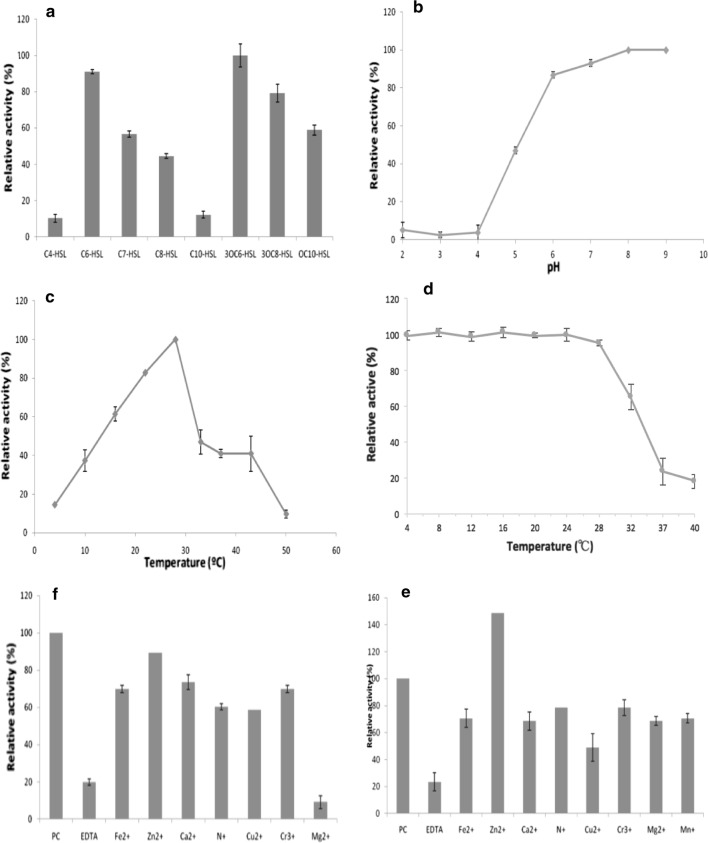Fig. 6.
a Substrate specificity of purified AidP. Purified AidP was mixed with substrate solutions in buffer (pH 7). After incubation at 25 °C for 30 min, the residual AHL and its hydrolysis products were quantified by RRLC. We defined 100% relative activity as the activity toward 3OC6-HSL. Each incubation was replicated at least three times, and error bars indicate standard deviation. b Optimal pH of the AHL-degrading activity of purified AidP. Purified AidP was mixed with 3-oxo-C6-HSL in reaction buffers with pH ranging from pH 2 to pH 9 and incubated at 25 °C. Each incubation was replicated at least three times, and error bars indicate standard deviation. c Optimal temperature of AHL-degrading activity of purified AidP. Purified AidP was mixed with 3OC6-HSL in reaction buffer (pH 7) and incubated at temperatures ranging from 4 to 50 °C. After incubation for 30 min, the residual substrate was quantified by RRLC. We defined 100% relative activity as the activity in the reaction buffer (pH 7) at 25 °C. Control samples, which had been prepared under the same conditions but without AidP, were used to exclude the influence of autodegradation at high pH or high temperature. Each incubation was replicated at least three times, and error bars indicate standard deviation. e Thermal stability of AidP. Purified AidP reaction buffer (pH 7) was incubated at temperatures ranging from 4 to 40 °C for 30 min before subjected to AHLs inactivation assay with 3-oxo-C6-HSL. After incubation for 30 min, the residual substrate was quantified by RRLC. We defined 100% relative activity as the activity in the reaction buffer (pH 7) at 25 °C. Each incubation was replicated at least three times, and error bars indicate standard deviation. The effects of EDTA and various metal ions on the AHL-degrading activity of AidP in in vitro (e) and in vivo (f) assays. For the in vitro assay, purified AidP was incubated in reaction buffer containing substrate and a 1 mM concentration of the appropriate metal ion. After incubation at 25 °C for 30 min, the residual activity of AidP was analyzed by RRLC. For the in vivo assay, E. coli BL 21 Star™ harboring pET200-aidP was cultivated with 1 mM EDTA and a 1 mM concentration of the appropriate metal ion. Crude cell extracts were then prepared and used for the AHL-degradation assay. We defined 100% relative activity as the activity in the absence of EDTA or metal ions, and represented the PC (positive control). Each incubation was replicated at least three times, and error bars indicate ± 1 standard deviation

